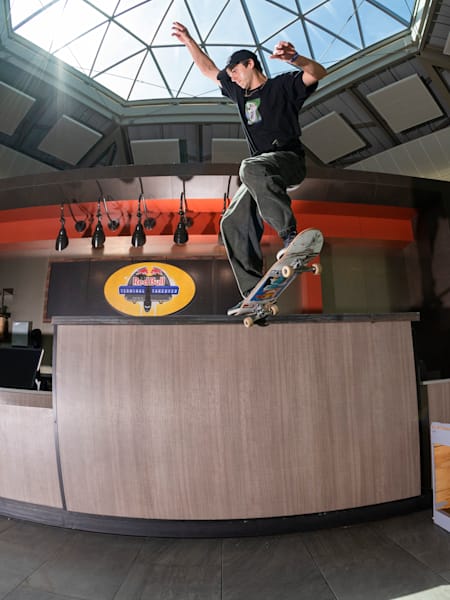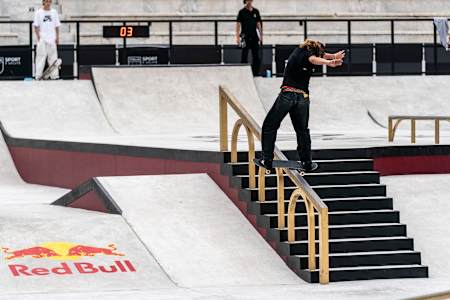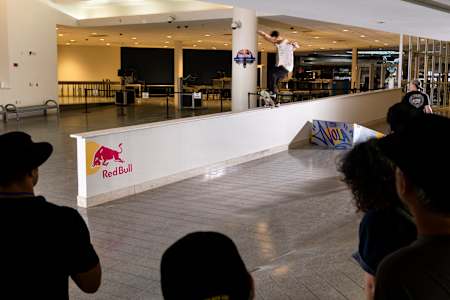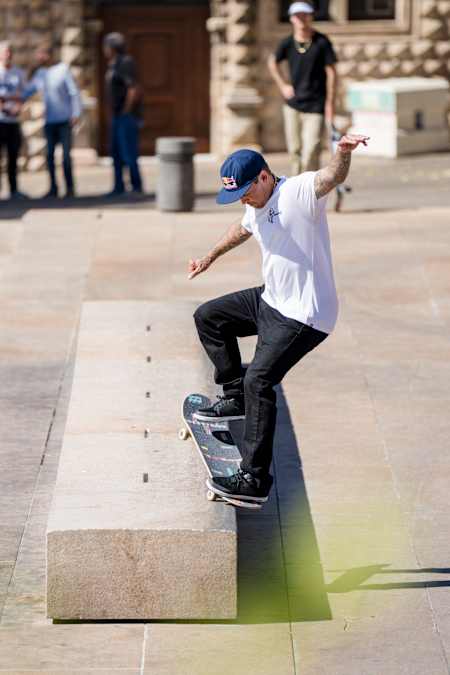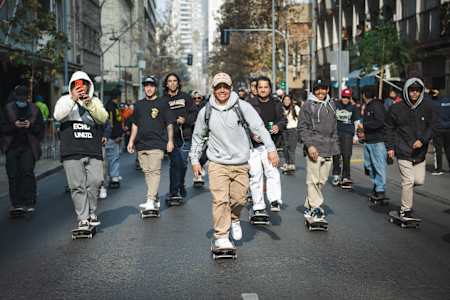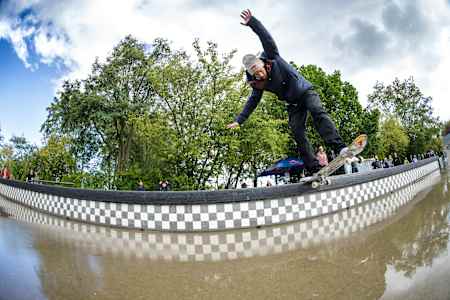Skateboarding
Discovering the joys of riding a skateboard can be a transformative experience. For Red Bull skater Jagger Eaton, his early days of skateboarding were life-altering.
“My dad showed me everything about skateboarding,” he recalls. “I loved it from the very beginning.”
Jagger Eaton at the 2021 World Street Skate Championships in Rome, Italy
© Luis Gallo / Red Bull Content Pool
Before you can wow a crowd, though, you have to learn the basics, and a big part of skateboarding 101 is getting your balance right. After all, balance is the foundation for just about everything you can do on a skateboard. There are plenty of ways you can work on getting it right, both on and off the board. Read ahead for five skateboard balance tips that will help keep you stable and secure as you coast down the street or a head to a halfpipe.
01
Strengthening exercises
When it comes to balance, it’s all about your core. This is as true for skateboarding as it is for other athletics, from gymnastics to yoga. Leg and ankle strength play a role too, but your core is what connects everything. Get your skateboarding muscles in shape off the board, with or without equipment, with these moves.
Julian Christianson at Red Bull Terminal Takeover on April 13th, 2023
© Jonathan Mehring / Red Bull Content Pool
Planks
This tried and true core strengthening pose resembles getting into position for a push-up — and staying there. You can modify this exercise with supported versions where you plank with your knees and elbows on the ground. You can also try a side plank for a new challenge. This requires balancing on a tilt with the support of only one hand and foot.
Squats
Squats are a great way to strengthen many muscles at once. As you bend your legs into a squat position, you’re toning knee muscles that will be important for staying on your board. Keeping your whole foot, heel to toe, on the ground is also a great way to practice stable footing. Eventually, you might be able to practice this exercise on your skateboard itself.
Lunges
With one foot forward and one foot back, lunges are a great way to practice balancing in a skateboard stance. Core control keeps you upright as you bend your front-facing knee. As you lower your back knee so it’s hovering just above the ground, you also target your hamstrings, glutes, calves, and quads.
02
Balance board training
Ryan Sheckler at Red Bull Drop In Tour 2022 in Marseille, France
© Anthony Acosta / Red Bull Content Pool
A balance board is a piece of exercise equipment used in routine workouts and for physical therapy. Generally, you’ll stand on a flat-top surface with an unstable base and shift your weight from side to side to stay balanced. You’ll often find variations with a long, rectangular, skateboard-like deck and a round base. You can also start small, especially as you build ankle strength, with options such as small, rounded wobble boards.
If you’re adding a balance board to your training, here are some tips to get you started.
- Start small. At first, work to balance on the board for 30 seconds at a time.
- Move side to side. As you start feeling more confident, going back and forth can strengthen your muscles and get you ready for navigating on an actual skateboard. On a wobble board, you can also practice tilting forward and backward.
- Target other areas. Once you’ve gotten the hang of the essentials, continue to challenge yourself with exercises such as balance board-supported planks. This is a great way to strengthen all the muscle groups in your core.
03
Practice on flat ground
Marcelo Jimenez during Go Skateboarding Day in 2022 in Santiago, Chile
© Luis Barra / Red Bull Content Pool
When you’re ready to apply your balance practices to an actual skateboard, start on an even surface. Stance plays a huge role in staying upright, so it’s smart to begin there. The two main stances in skateboarding are “regular,” with your left foot facing front, and “goofy,” involving a right front foot. As you work to find the stance that fits you, here are some additional techniques for balancing on a flat surface.
- Keep your center of gravity low. Staying low with a slight bend in the knees will make it easier to stay on the board.
- Work on foot placement. Angle your front-facing foot slightly and place it at the front of your board. Place your back foot, near the tail of the board, perpendicular to the board.
- Try one foot at a time. Once you’re comfortable in a wide-legged stance, you can test your abilities and try balancing on just your front or back foot.
- Switch your stance. Riding “switch” (with your feet the opposite of your usual) can increase your strength, kind of like resistance training in other sports.
04
Increase confidence
Torey Pudwill at Red Bull Drop In Tour 2022 in Cologne, Germany
© Anthony Acosta / Red Bull Content Pool
Just as with any other physical skill, muscle memory plays a huge role in balance. Practicing over time gets you used to sensing your center of gravity and perceiving your body’s position in space. This skill takes time to develop, so be patient with yourself — if you fall down, don’t be afraid to get back up. Here are some things you can do to boost your confidence as you build up your strength.
- Start gradually and remember it takes time. You don’t need to rush from the basics to ollies in a day. Take your time with the beginner-level work before you move on to the more challenging exercises.
- See the move in your mind first. It’s common for athletes to get into the right mindset by visualizing the move before performing. Envisioning a trick first can help you focus on exactly where you need to go.
- Learn from your mistakes. Falling is just part of the learning process. Instead of beating yourself up, you can reframe the experience. Now, you know what doesn’t work, and with that knowledge, you can improve on the next try.
05
Proper equipment
Brighton Zeuner at Women's Park Semifinal 2021 at Dew Tour in Des Moines
© Mark Clavin / Red Bull Content Pool
While your own muscles do most of the work, the right gear can also contribute to good balance on your skateboard. From protecting yourself through those first few falls to finding the right board, here’s what you’ll need to get started.
- Sturdy skate shoes. Finding the right footing is much easier in flat and firm closed-toe shoes. Thick-soled shoes are typically best at absorbing the impact that comes with flipping or turning your board.
- Protective gear. Since falls are expected as you learn, preventing injury is important for maintaining your confidence. A helmet is the most essential piece of safety equipment, and knee pads or wrist guards can also protect your joints from impacts.
- The right skateboard. When you buy your first skateboard, you can choose between a long or short skateboard deck. Some say longboards are easier to learn with since the additional coverage can support more balance. But there’s no right or wrong rule here — it’s whatever feels right to you.
Practice makes progress
Perfect balance isn’t a requirement to dip your toe into the world of skateboarding — you just need to commit to your practice. In time, you’ll gain more experience and trust yourself on your board. And once you’ve mastered the essentials of skateboarding, you can try some more challenging tricks from the pros. After all, those gravity-defying, jaw-dropping moments are probably what inspired you to get on a skateboard in the first place. With great balance, you’re one step closer to pulling them off.

